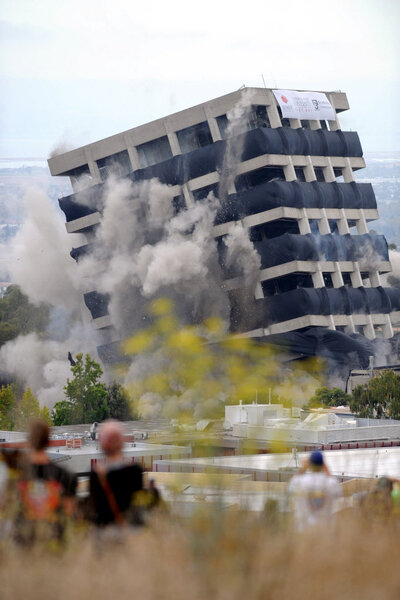Hayward implosion: Scientists work to predict the next 'Big One'
Loading...
| Hayward, Calif.
With a series of quick blasts and a cloud of dust a 13-story building on the Cal State-East Bay campus crashed to the ground Saturday morning as scientists monitored the impact on the nearby Hayward Fault.
The controlled implosion on a hillside above the San Francisco Bay also attracted scores of gawkers eager to feel the magnitude 2.0 shockwaves scientists predicted would occur from 12,500 tons of crashing concrete and steel.
US Geological Survey scientists had placed more than 600 seismographs in concentric circles within a mile of the building to pick up the vibrations.
They hope the unique experiment will help map out where the ground might shake the most when the big one hits, though the data collected Saturday will take at least three months to analyze.
"When that building dropped we should have gotten a nice, continuous signal for eight to 10 seconds," said Rufus Catchings, the lead USGS scientist on the project, minutes after the dust settled.
Catchings said he was happy with the execution of the implosion that caused the distinctive building on an East Bay hillside to collapse from view in fewer than five seconds.
"It was so fast it was over before you knew it," said Sally Lopez, 71, who met her husband when both were students at the school and came from nearby Fremont to watch the building drop.
The entire experiment is an attempt to answer the question: What will happen when the next Big One strikes?
For years now, the region has been bracing for a major earthquake that many worry could level vulnerable schools, hospitals and apartment buildings and unleash near-apocalyptic chaos. The USGS estimates there is a 63 percent chance of a major earthquake in the region within the next three decades.
The 13-story Warren Hall was built about 2000 feet from what researchers call one of the most dangerous fault lines in the country.
"We're just getting an idea of the distribution of the shaking," said scientist Catchings.
Many vividly remember the magnitude-6.9 Loma Prieta earthquake in 1989 that killed 63 people, injured almost 3,800, caused up to $10 billion damage, including a collapsed freeway that killed dozens of drivers. That quake was centered near Santa Cruz, about 50 miles south of here.
But in the East Bay, the Hayward fault — which runs through East Bay cities and under the University of California, Berkeley's football stadium — is the most likely to act up and cause a major earthquake in the next few decades, experts say.
The last major temblor on the Hayward fault was in 1868, Catchings said. He said the fault triggers a major earthquake every 140 years on average.
And it's not just the fault line residents have to worry about. Additional fault lines —called traces — split off from the main fault, and the location of many is unknown. The vibrations set off by Warren Hall's implosion will help scientists figure out where they are.
"In the event of a large earthquake, oftentimes it's not just one break in the ground, it's spread out over some distance," Catchings said. "You'd kind of like to know where all these things are if you really want to understand the hazard."
Mark Salinas, Hayward's mayor pro tem, said knowing where the ground shakes will help the city decide where to put new housing and other buildings. "This data, when it's available, will inform us on future development," he said.
The idea to use the building's demolition came from Luther Strayer, a geology professor at the university who called the USGS to see if they would be interested.
"Anybody in my position who is trained like I am would have recognized the opportunity," Strayer said. "That's really the cool part; it was sort of a simple obvious thing to do and it can do so much good for our society and the community."








